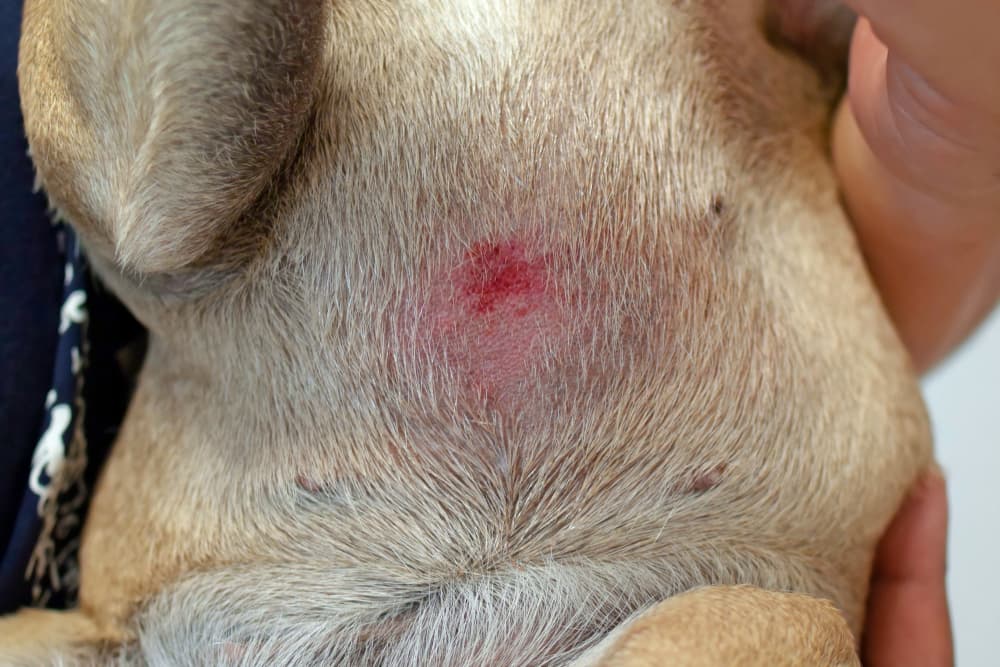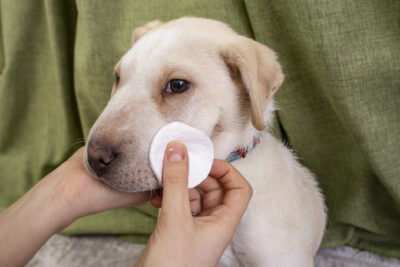Pyoderma in Dogs

Overview
- Pyoderma is a bacterial skin infection where pus is present in the skin.
- It often takes the form of pimples, bumps, or oozy hot spots.
- Allergies, parasites, hormonal disorders, and more can be causes of pyoderma.
- Treatment includes antibiotics, +/- medicated shampoos, sprays, or lotions, and addressing the underlying cause.
- Managing underlying health issues and regular bathing and grooming can help prevent pyoderma in dogs.
Many things can cause itchy, irritated skin in dogs. But if you’ve noticed your dog is scratching and biting at red, pus-filled blisters or pimples, they may have a pyoderma, or a bacterial skin infection.
If your pup has a breakout that smells icky or just seems to be a constant bother, that’s your cue to call your veterinarian.
Wondering what’s gotten under your pup’s skin? Read on to learn everything you need to know about pyoderma in dogs, including what causes it, whether it’s contagious, and how to treat it.
What Is Pyoderma?

Pyoderma is veterinarian-speak for a bacterial skin infection where pus (‘pyo’) is present in the skin (‘derma’), often in the form of pimples, bumps, or oozy hot spots (‘moist pyoderma’). Dogs of all ages and breeds can develop pyoderma, which is often referred to as impetigo in puppies.
In most cases, dogs have superficial pyoderma, which is just what it sounds like: an infection that affects the outermost layers of skin as well as surrounding hair follicles (this is called bacterial folliculitis).
Often, pyoderma is caused by common bacterial agents like Staph, explains Dr. Karyn L. Collier, medical director for wellness medicine at the Saint Francis Veterinary Center of South Jersey in Turnersville and Woolwich Township, New Jersey.
Sometimes, though, dogs develop a deep pyoderma, in which bacteria invades and infects deeper layers of skin as well.
Is Pyoderma in Dogs Contagious?
In itself, pyoderma is not contagious. However, some of the causes of a pyoderma can move from dog to dog or be shared, such as fleas.
What Causes Pyoderma in Dogs?

Like humans, dogs move through the world with bacteria and yeast on the surface of their skin, but when that barrier is broken, bacteria and yeast can invade and cause an infection.
It’s important to understand that pyoderma isn’t something your dog just gets, but rather something that could develop from something else, says Dr. Collier.
Risk factors for a pyoderma include (1):
- Allergies to food and environment
- Parasites like fleas, ringworm, mange mites, and ticks
- Underactive or weakened immune system due to diabetes, autoimmune diseases, or endocrine diseases like Cushing’s disease
- Immunosuppressive drugs for immune-mediated diseases such as inflammatory bowel disease
- Poor nutrition
Furthermore, moist lip, skin, neck folds, and nail beds serve as the perfect environment for bacterial or yeast overgrowth and a resulting pyoderma. This puts breeds with wrinkles, including Bulldogs and Shar-Peis, at risk of developing a pyoderma, says Dr. Jennifer Pearl, assistant director of the Animal Medical Center of Mid-America in St. Louis City and Maryland Heights, Missouri.
Symptoms of Pyoderma in Dogs
Early signs of pyoderma in dogs are hard to ignore because your pup is likely to be biting, licking, and scratching away at red, inflamed skin. You may notice red bumps, pimples, and crusted skin, as well as hair loss, says Dr. Collier.
Puppies with impetigo tend to develop small, red bumps in areas such as their underarms, belly, and groin, though dogs can develop pyoderma anywhere on their skin.
Your dog may be dealing with pyoderma if they have any of the following symptoms (1):
- Red, fluid filled bumps
- Pus-filled blisters or pimples
- Crusted skin
- Moist, oozing skin lesions
- Rash or patches of red, inflamed skin
- Hair loss (alopecia)
- Skin odor
- Chronic scratching and biting at the skin
If you notice any type of rash or redness on your dog’s skin that doesn’t go away or if your dog is spending a lot of time scratching and chewing at their skin, contact your veterinarian to schedule an exam, advises Dr. Pearl.
Diagnosing Pyoderma

When you visit your veterinarian, a physical exam and tests can help them figure out whether or not your dog has pyoderma or another condition, says Dr. Pearl.
Typically, tests include skin cytology (which allows your veterinarian to view skin cells under a microscope to identify bacteria or yeast causing the infection), a fungal culture (which can be used to check for ringworm fungus), skin scrapings (which can reveal microscopic mange mites), and a sensitivity panel (which determines which antibiotic will be most effective).
How to Treat Pyoderma in Dogs
At first, pyoderma in dogs can be scary—a fiery red rash could be anything, and no one wants to see their dog uncomfortable or in pain. But thankfully, most cases of pyoderma in dogs clear up with proper veterinary care and a little TLC.
Treatment of pyoderma in dogs involves eliminating infection, says Dr. Collier. Commonly prescribed antibiotics include cephalexin and cefpodoxime, which are generally effective and well tolerated.
Additionally, the following can help repair your pup’s skin and make them feel more comfortable:
Other products may be used in addition or in place of antibiotics to help clear up a skin infection. These products often contain a topical antibacterial, antifungal, and/or other ingredients that help improve the skin’s condition:
- Medicated shampoos
- Mousses
- Antibacterial pads
- Sprays
For dogs with chronic health conditions that make them more prone to pyoderma, it’s essential to treat and manage the root cause as well, says Dr. Pearl.
For example, dogs with allergies can benefit from the corticosteroid prednisone for short-term relief from itching and inflammation, while prescription allergy medications could be used for longer-term relief.
As your dog heals from their infection, grooming around the area can make the process easier. “Some patients with long and thick coats benefit from the coat being clipped to improve contact with the medicated shampoos or other topical agents used,” explains Dr. Collier.
Because bacterial infections can require several weeks of therapy, a re-check or progress exam is typically performed two weeks after your initial veterinary visit to make sure the infection has cleared, says Dr. Collier.
Ultimately, though, it’s crucial to figure out what’s causing the pyoderma. If your dog’s infection doesn’t clear up or itchiness continues after treatment, your veterinarian may need to run additional tests.
Blood screening for organ function and blood cell counts is often recommended, as well as thyroid testing. Special blood testing for other hormonal diseases or allergies may also help clarify what’s at the root of your dog’s discomfort.
Cost to Treat Pyoderma in Dogs
As for how much treatment for pyoderma will cost you? On average, a mild case of pyoderma in dogs can be diagnosed and treated for $200 to $400. This includes exam costs ($50-$80), skin cytology ($50), culture ($150-$200), and treatment ($30-$70+ depending on the size of dog and medications used), says Dr. Collier.
However, the cost of treatment can vary vastly depending on other health conditions your dog may have and where you live and are seeking help, says Dr. Pearl.
How to Prevent Pyoderma in Dogs

In all dogs, routine grooming can help you detect any changes in your pet’s skin, and you may be able to identify pyoderma early on. This could minimize treatment needed for your pet if you are able to treat a mild infection. In dogs with longer coats and skin folds, regular bathing and grooming, including cleaning skin folds and keeping coats short and clean, can help prevent pyoderma from developing.
The best method for preventing pyoderma from coming back is to address underlying health issues such as hormonal disorders, parasites, and allergies.
Your veterinarian can help direct you toward appropriate dietary changes, parasite preventatives, and long-term medications.
Related Conditions
- Staph Infection
- Hot Spots
- Allergies
- Fleas
- Scabies
- Ringworm
- Hypothyroidism
- Diabetes
- Cushing’s Disease
- Autoimmune Diseases









